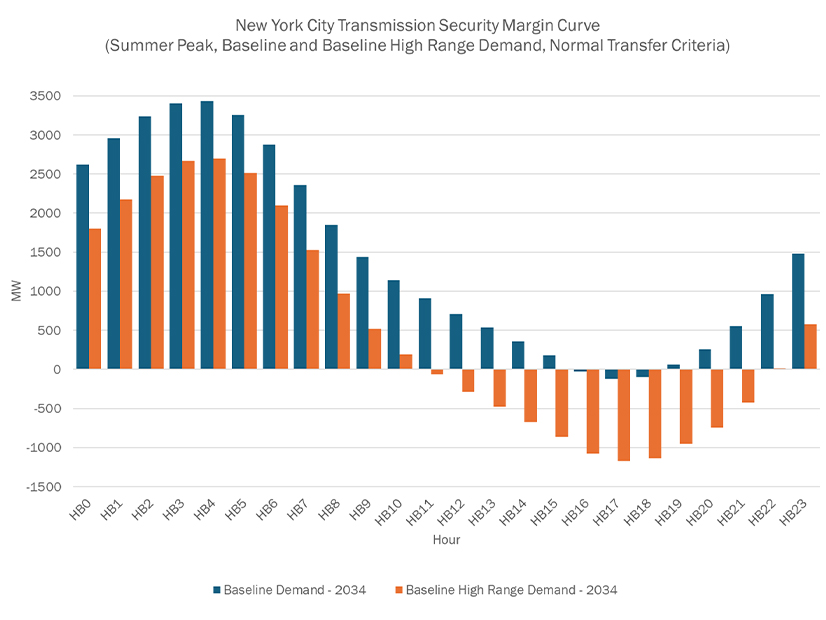NYISO on Oct. 4 released the first draft of its 2024 Reliability Needs Assessment (RNA) showing a capacity deficiency in New York City beginning in 2033 and proposing to declare a reliability need for its zone.
The deficit is driven by a combination of forecast increases in peak demand and the looming retirement of small gas plants in the city, NYISO said. The analysis found that on a peak summer day with expected weather conditions (95 degrees Fahrenheit), the city would be deficient by 17 MW for one hour in 2033, rising to 97 MW for three hours in 2034.
“This is based on the transmission security analysis and the feeding into the transmission security margin,” Ross Altman, senior manager of reliability planning for NYISO, told the Electric System Planning Working Group. “This is an actionable reliability need.”
The declaration of a reliability need triggers a process in which NYISO solicits solutions, including transmission-based from the local transmission owners, and generation and demand response from market participants. The ISO declared a short-term reliability need for the city last year, finding a potential 446-MW shortfall by 2025. It later decided to keep two natural gas peaker plants, collectively 565 MW, in Brooklyn operational beyond their state-mandated retirement as a solution. (See NYISO to Keep Gas Peakers Online to Solve NYC Reliability Need.)
The assessment assumes those units to no longer be available beginning in 2026. The state also recently enacted legislation to retire seven small New York Power Authority gas-fired plants in the city and Long Island worth 517 MW by the end of 2030.
“The reliability need could be met by combinations of solutions, including new generation, retention of planned generation retirements, transmission, energy efficiency, demand response measures or changes in operating protocols,” the draft says. “Specifically, scenarios performed in the RNA indicate that the New York City transmission security deficiency could be resolved by resources currently under development but not yet in the base case.”
NYISO had reported the possibility of such a deficiency for the city, but it had been overshadowed in meetings by a preliminary finding of a statewide shortfall of as much as 1 GW by 2034. The ISO, however, updated its assumptions about the flexibility of large loads — specifically, cryptocurrency mining and hydrogen-producing facilities — which reduced its loss-of-load expectation to less than 0.1.
Still, the ISO warned in its draft that the LOLE is “extremely close” to the maximum: 0.094. “The tightening margins are a significant concern that … NYISO will closely monitor and re-evaluate in future [Short-Term Assessments of Reliability] and the next cycle of the Reliability Planning Process.”
“We are just under a violation, and a big factor of that is the treatment of large loads,” Altman said.
Large Load Flexibility
Several stakeholders questioned how NYISO determined how certain large loads would be flexible and criticized the lack of any data on the topic.
“In your evaluations, did the cryptocurrency load representatives — whatever they are called — give you any idea about how much notice they would need to curtail their load?” asked Mark Younger, of Hudson Energy Economics.
Altman said he did not know and that he did not want to get too detailed on what NYISO discussed with the cryptocurrency companies because such information was “proprietary.”
“They provided enough information that [made NYISO] feel they would be flexible, either sensitive to prices or demand response,” Altman said. NYISO did not forecast the price of Bitcoin or other cryptocurrencies, he said.
“For other resources, whether it’s SCRs [special-case resources] or generators, … NYISO has tariff provisions and other goals that require submission of information so you guys can track what’s going on,” said Kevin Lang of Couch White. “This is the only place I can think of where there’s absolutely nothing — no reporting requirements, no obligations — … and yet from the tables you’re showing us, if these loads continue to operate during peak periods, we have a very significant problem.”
“We are engaged in bilateral discussions and surveying with these large loads in terms of the nature of these large loads and their intention to operate,” said Tim Duffy of NYISO, explaining that operating procedures and interconnection studies were also sources of information. “NYISO is really reliant upon transmission owners to gather that data.”
“I appreciate the explanation, but I just think, given how critical this is to your assumptions, that there should be something more formalized with these loads,” Lang replied.
Tight Deadlines, Annoyed Stakeholders
Stakeholders expressed numerous criticisms of the draft’s publications, including the lack of an executive summary: The opening section simply says “Reserved for future drafts.”
They were also annoyed that NYISO released the draft on a Friday, with multiple stakeholder meetings scheduled that day, with a deadline for comment the following Monday (Oct. 7).
“I am going to bust your chops,” Younger said. “The ISO needs to be rethinking the timeline that they hope that market participants can provide useful feedback on this, given how late it came out and also given that it came out at the same time that many of them are dealing with a critical step in the Demand Curve Reset, a timeline that was well known in advance.”
Several sections, including those detailing the New York City reliability need and the narrowly avoided statewide need, were worded confusingly, stakeholders said.
“My personal opinion is that NYISO has bungled some of the communication efforts around recent reliability reports,” said Chris Casey, utility regulatory director for the Natural Resources Defense Council. “I think it’s important for us to have time to be able to not only understand what the data and findings are, but make sure the narrative matches reality. I don’t think we were given time to do that here.”
Doreen Saia of Greenberg Traurig requested that NYISO allow more time for discussion at the working group’s meeting Oct. 9.
“We are going way too fast on an area that is completely charting new ground,” Saia said.
Lang pointed out that NYISO had provided executive summaries on previous RNA reports for 2018, 2020 and 2022.
“You are going way too fast, and you aren’t giving market participants sufficient time to understand what’s really going on here,” Lang said.



